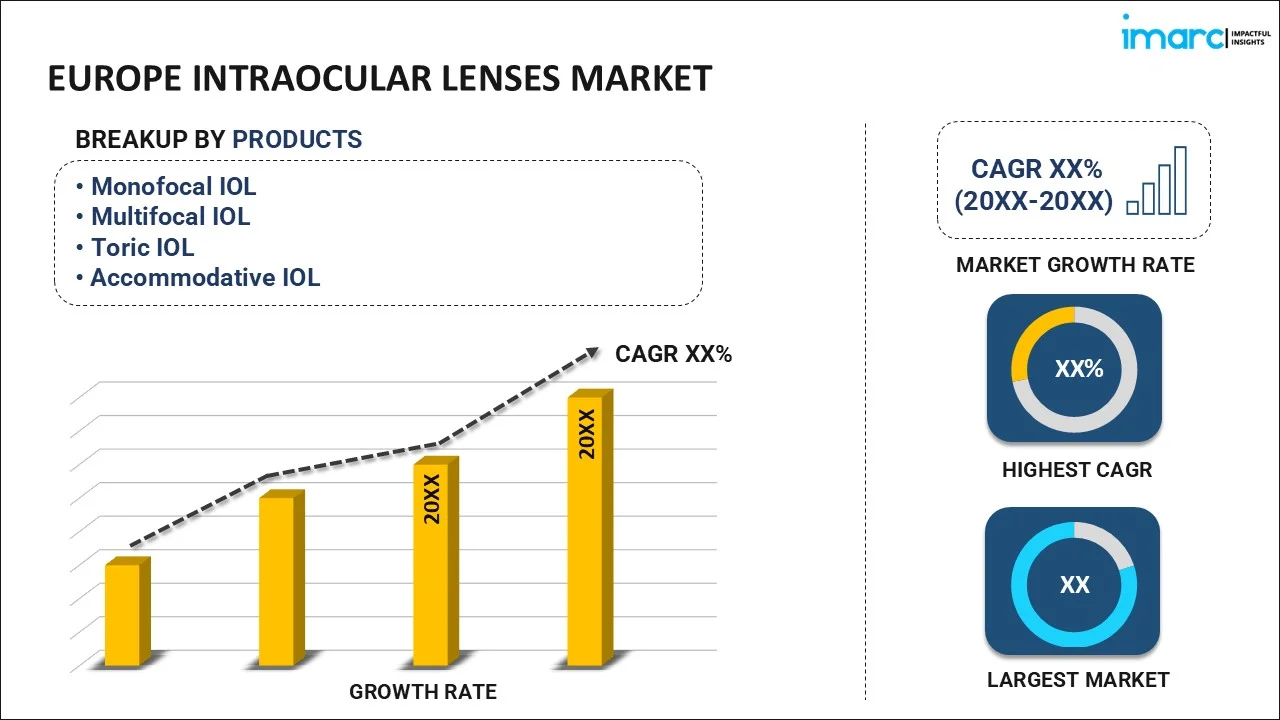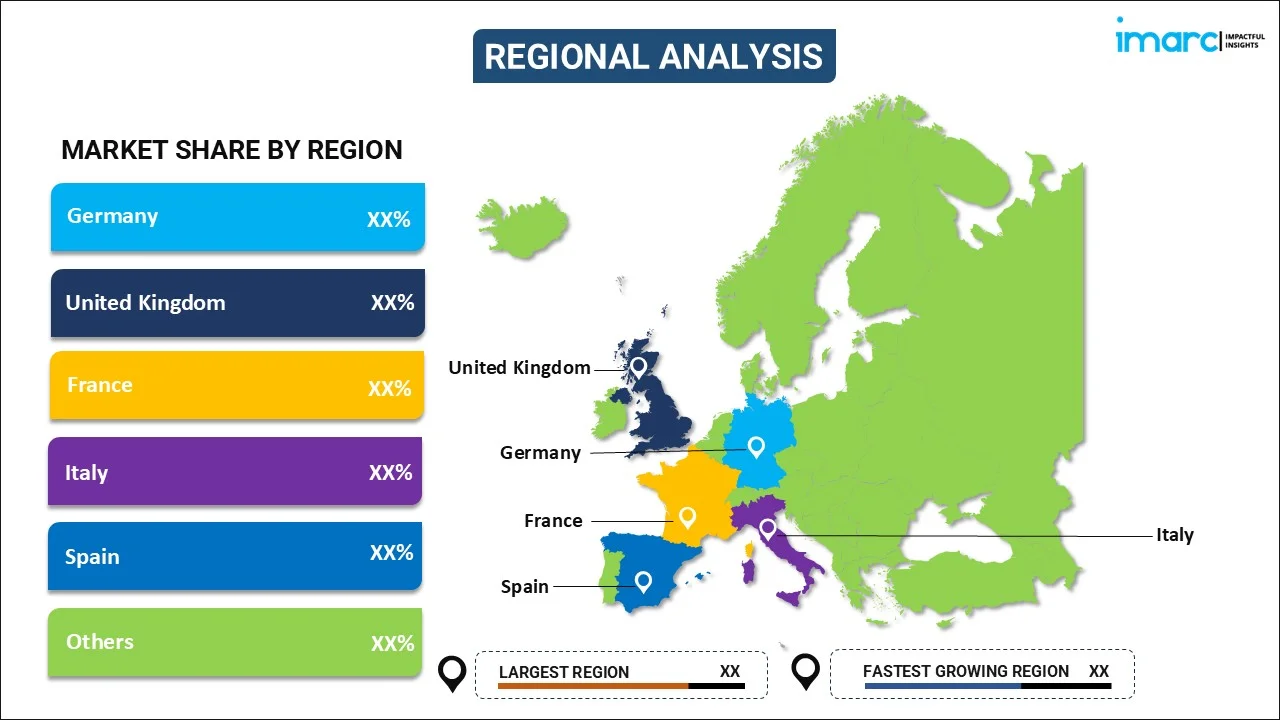
Europe Intraocular Lenses Market Size, Share, Trends and Forecast by Product, Material, End Use and Region, 2025-2033
Europe Intraocular Lenses Market Overview:
The Europe intraocular lenses market size reached USD 1,107.54 Million in 2024. Looking forward, IMARC Group expects the market to reach USD 1,645.92 Million by 2033, exhibiting a growth rate (CAGR) of 4.50% during 2025-2033. The market is witnessing significant growth, driven by surge in cataract surgeries and rising adoption of premium IOLs. Significant research and development (R&D) is also contributing to the market growth across the region.
|
Report Attribute
|
Key Statistics
|
|---|---|
|
Base Year
|
2024 |
|
Forecast Years
|
2025-2033
|
|
Historical Years
|
2019-2024
|
| Market Size in 2024 | USD 1,107.54 Million |
| Market Forecast in 2033 | USD 1,645.92 Million |
| Market Growth Rate (2025-2033) | 4.50% |
Europe Intraocular Lenses Market Trends:
Surge in Cataract Surgeries
The increased number of cataract surgeries in Europe constitutes one of the major drivers of the intraocular lens market growth. With cataract prevalence steadily on the rise in an increasingly aging European population, the demand for IOLs becomes greater. According to the most recent demographic projections, a notable increase in the elderly population across Europe is expected in the near future, which is a direct correlate of increasing incidence of cataracts. Cataract surgery is one of the most widely performed surgical procedures in Europe, with millions of cataract surgeries being performed each year. The demand for IOLs rises as patients request better quality of life and better visual outcomes, especially with the advent of multifocal and toric lenses. Such surgeries enhance vision and improve patients' overall well-being, further boosting this market expansion. For example, September 2024 witnessed the launch of the RayOne Galaxy and RayOne Galaxy Toric IOLs by Rayner at the ESCRS congress. These lenses are AI-generated providing a smooth full range of vision with minimal light loss. Early detection and treatment of cataracts are contributing factors to the rising volume of surgeries. With improved diagnostics and public education, more patients are presenting for cataract surgery at earlier stages, thereby adding to greater demand for intraocular lenses.
Rising Adoption of Premium IOLs
Another crucial emerging trend in the field of European IOL markets is the growing trend toward the use of premium-quality intraocular lenses. These lens types, which include the multifocal, accommodating, or toric forms, are expected to be amongst the most affordable ones enabling their superior visual outcomes; hence many patients have turned to using them for improving their near, intermediate, and the distance vision without dependence or with lesser use of corrective eyeglasses post-cataract surgery. Such advanced solutions show an increase in the demand from patients addressing presbyopia and astigmatism, hence making the premium IOL more popular in Europe. The demand for premium intraocular lenses continues to grow where other factors include improved ICT and the possibility of advanced technology applications in design and materials for premium lenses. For instance, in January 2025, Bausch + Lomb announced the expansion of its product lines by launching enVista Aspire monofocal and toric intraocular lenses in the EU. These include Intermediate Optimised optics and 3C technology, with the possibility of treating astigmatism reducing the treatable range down to <1.0D in cataract surgery. Advances in aspheric lenses are reducing optical aberrations, while new developments in biocompatible materials promise enhanced visual clarity and comfort for patients. Increasing awareness and availability of premium lenses along with a flow of increased health care affordability in some Europe countries is facilitating the market growth. Premium IOLs are now being reimbursed by an increasing ratio in many European health systems, thereby making them affordable and expanding their accessibility to a wider patient base.
Europe Intraocular Lenses Market Segmentation:
IMARC Group provides an analysis of the key trends in each segment of the market, along with forecasts at the country level for 2025-2033. Our report has categorized the market based on product, material, and end use.
Product Insights:

- Monofocal IOL
- Multifocal IOL
- Toric IOL
- Accommodative IOL
The report has provided a detailed breakup and analysis of the market based on the product. This includes monofocal IOL, multifocal IOL, toric IOL, and accommodative IOL.
Material Insights:
- Polymethylmethacrylate (PMMA)
- Silicone
- Hydrophobic Acrylic
A detailed breakup and analysis of the market based on the material have also been provided in the report. This includes polymethylmethacrylate (PMMA), silicone, and hydrophobic acrylic.
End Use Insights:
- Hospitals
- Ophthalmic Clinics
- Ambulatory Care Centers
- Eye Research Institutes
A detailed breakup and analysis of the market based on the end use have also been provided in the report. This includes hospitals, ophthalmic clinics, ambulatory care centers, and eye research institutes.
Regional Insights:

- Germany
- France
- United Kingdom
- Italy
- Spain
- Others
The report has also provided a comprehensive analysis of all the major regional markets, which include Germany, France, United Kingdom, Italy, Spain, and others.
Competitive Landscape:
The market research report has also provided a comprehensive analysis of the competitive landscape. Competitive analysis such as market structure, key player positioning, top winning strategies, competitive dashboard, and company evaluation quadrant has been covered in the report. Also, detailed profiles of all major companies have been provided.
Europe Intraocular Lenses Market News:
- In April 2024, Alcon presented its Vision Suite portfolio, including advanced diagnostics, IOLs, and the Wavelight refractive platform. The company intends to enhance patient outcomes and operational efficiency.
Europe Intraocular Lenses Market Report Coverage:
| Report Features | Details |
|---|---|
| Base Year of the Analysis | 2024 |
| Historical Period | 2019-2024 |
| Forecast Period | 2025-2033 |
| Units | Million USD |
| Scope of the Report |
Exploration of Historical Trends and Market Outlook, Industry Catalysts and Challenges, Segment-Wise Historical and Future Market Assessment:
|
| Products Covered | Monofocal IOL, Multifocal IOL, Toric IOL, and Accommodative IOL. |
| Materials Covered | Polymethylmethacrylate (PMMA), Silicone, and Hydrophobic Acrylic |
| End Uses Covered | Hospitals, Ophthalmic Clinics, Ambulatory Care Centers, Eye Research Institutes. |
| Regions Covered | Germany, France, United Kingdom, Italy, Spain, Others. |
| Customization Scope | 10% Free Customization |
| Post-Sale Analyst Support | 10-12 Weeks |
| Delivery Format | PDF and Excel through Email (We can also provide the editable version of the report in PPT/Word format on special request) |
Key Questions Answered in This Report:
- How has the Europe intraocular lenses market performed so far and how will it perform in the coming years?
- What is the breakup of the Europe intraocular lenses market on the basis of product?
- What is the breakup of the Europe intraocular lenses market on the basis of material?
- What is the breakup of the Europe intraocular lenses market on the basis of end use?
- What is the breakup of the Europe intraocular lenses market on the basis of region?
- What are the various stages in the value chain of the Europe intraocular lenses market?
- What are the key driving factors and challenges in the Europe intraocular lenses?
- What is the structure of the Europe intraocular lenses market and who are the key players?
- What is the degree of competition in the Europe intraocular lenses market?
Key Benefits for Stakeholders:
- IMARC’s industry report offers a comprehensive quantitative analysis of various market segments, historical and current market trends, market forecasts, and dynamics of the Europe intraocular lenses market from 2019-2033.
- The research report provides the latest information on the market drivers, challenges, and opportunities in the Europe intraocular lenses market.
- Porter's five forces analysis assist stakeholders in assessing the impact of new entrants, competitive rivalry, supplier power, buyer power, and the threat of substitution. It helps stakeholders to analyze the level of competition within the Europe intraocular lenses industry and its attractiveness.
- Competitive landscape allows stakeholders to understand their competitive environment and provides an insight into the current positions of key players in the market.
Need more help?
- Speak to our experienced analysts for insights on the current market scenarios.
- Include additional segments and countries to customize the report as per your requirement.
- Gain an unparalleled competitive advantage in your domain by understanding how to utilize the report and positively impacting your operations and revenue.
- For further assistance, please connect with our analysts.
 Inquire Before Buying
Inquire Before Buying
 Speak to an Analyst
Speak to an Analyst
 Request Brochure
Request Brochure
 Request Customization
Request Customization




.webp)




.webp)












